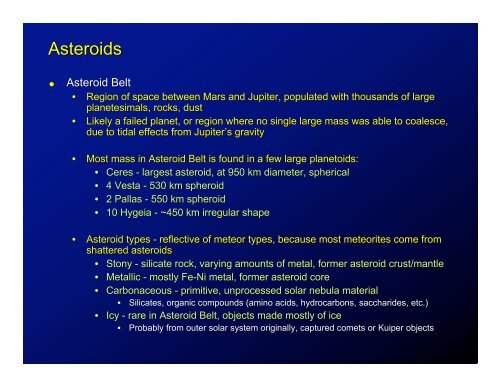Part 4
Part 4
Part 4
Create successful ePaper yourself
Turn your PDF publications into a flip-book with our unique Google optimized e-Paper software.
Asteroids<br />
! Asteroid Belt<br />
• Region of space between Mars and Jupiter, populated with thousands of large<br />
planetesimals, , rocks, dust<br />
• Likely a failed planet, or region where no single large mass was able to coalesce,<br />
due to tidal effects from Jupiter’s s gravity<br />
• Most mass in Asteroid Belt is found in a few large planetoids:<br />
• Ceres - largest asteroid, at 950 km diameter, spherical<br />
• 4 Vesta - 530 km spheroid<br />
• 2 Pallas - 550 km spheroid<br />
• 10 Hygeia - ~450 km irregular shape<br />
• Asteroid types - reflective of meteor types, because most meteorites come from<br />
shattered asteroids<br />
• Stony - silicate rock, varying amounts of metal, former asteroid crust/mantle<br />
• Metallic - mostly Fe-Ni metal, former asteroid core<br />
• Carbonaceous - primitive, unprocessed solar nebula material<br />
• Silicates, organic compounds (amino acids, hydrocarbons, saccharides, , etc.)<br />
• Icy - rare in Asteroid Belt, objects made mostly of ice<br />
• Probably from outer solar system originally, captured comets or Kuiper objects

















